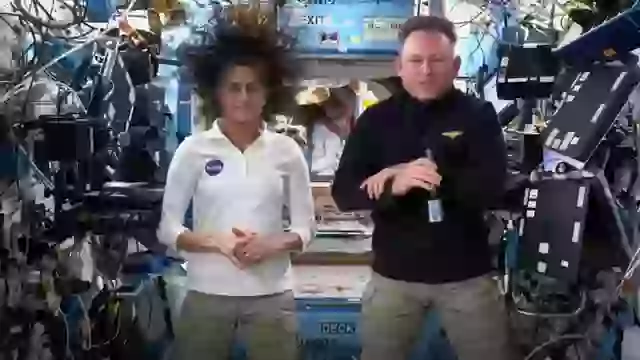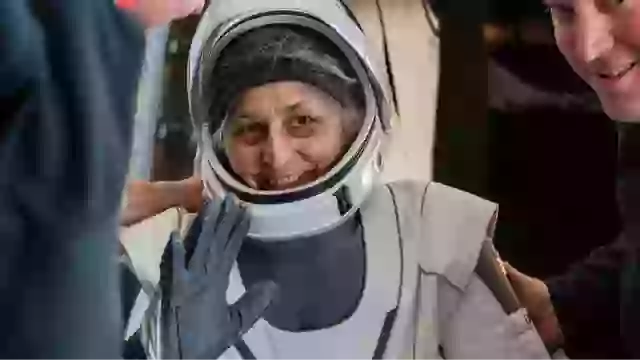After an unprecedented nine months trapped aboard the International Space Station—far exceeding their original eight-day mission—NASA astronauts Butch Wilmore and Suni Williams finally returned to Earth this week. Yet, while the splashdown marked an end to their space ordeal, experts warn that the astronauts’ eyes might never fully recover from their prolonged exposure to microgravity.
According to Tina Patel, a respected contact lens optician and eye health specialist, the extreme duration spent orbiting Earth may have inflicted permanent, irreversible changes to Wilmore’s and Williams’ vision. Patel emphasizes that while astronauts rigorously train for the harsh realities of space travel, the human eye remains vulnerable to the uniquely challenging conditions of long-term weightlessness.

In microgravity, astronauts’ bodies undergo unexpected physiological shifts. Without Earth’s gravitational pull directing bodily fluids downward, fluids instead accumulate around the head. This fluid redistribution dramatically raises intracranial pressure, a condition known among space medicine experts as Spaceflight-Associated Neuro-ocular Syndrome (SANS).
Patel explains, “When astronauts spend prolonged periods floating in space, fluid builds up inside their skull, pressing heavily on the eyes. This pressure physically reshapes the eyeball, flattening its rear surface and potentially leading to optic nerve swelling—a condition medically termed papilledema.”
For astronauts, these physical transformations can trigger significant visual disturbances, ranging from blurred eyesight and double vision to severe difficulties focusing clearly on nearby objects. Alarmingly, Patel suggests these ocular impairments could linger long after astronauts return to Earth.
Beyond the immediate fluid-related complications, there’s another factor at play: cosmic radiation exposure. Patel highlights growing scientific concerns that extended periods in space, subjected to constant bombardment by cosmic rays, could accelerate retinal deterioration. Such prolonged radiation exposure might lead to conditions resembling premature aging within the eyes, further compounding visual impairment.

Given these substantial risks, NASA now closely monitors astronauts’ eyesight upon their return to Earth. Patel notes that astronauts undergo thorough eye examinations involving advanced imaging technologies such as optical coherence tomography (OCT). These tests allow specialists to identify retinal damage and assess the overall health of ocular nerves and tissues in microscopic detail.
Thankfully, Patel points out, effective treatment options do exist. Prescription eyewear can often correct vision problems stemming from structural changes. However, for astronauts experiencing persistent nerve swelling, careful long-term medical observation and treatment become necessary, underscoring the lasting seriousness of these space-induced ailments.
NASA is also proactively developing countermeasures to minimize the impact of extended space stays. Patel highlights how astronauts have begun using innovative lower-body negative pressure suits, designed to replicate gravity’s natural effects by drawing fluids away from the head and back toward the legs. Such technological innovations hold promise in preventing or reducing ocular harm on future missions.
Additionally, eye rehabilitation exercises and targeted therapy techniques are being studied and implemented to expedite astronauts’ recovery upon their return. These practices aim not only to rehabilitate damaged eyesight but also to strengthen eye muscles compromised by prolonged disuse in microgravity.
One of the most critical issues facing space medicine specialists, Patel says, remains the unpredictable duration of these visual impairments. “Some astronauts experience noticeable improvements within just weeks,” Patel acknowledges, “but others may face ongoing visual complications lasting months or even years.”
In the most severe cases, the structural alterations caused by prolonged optic nerve pressure may be irreversible. The potential permanence of these conditions significantly complicates future deep-space missions, particularly planned explorations to Mars, where immediate medical interventions would be impossible.

The implications extend beyond space travel itself. Patel explains how studying astronauts’ vision challenges contributes essential knowledge applicable here on Earth. Conditions like idiopathic intracranial hypertension, a disorder characterized by elevated skull pressure leading to severe vision problems, bear similarities to SANS. Understanding space-induced eye damage could yield valuable insights and novel treatments for these terrestrial medical issues.
Ultimately, Patel emphasizes the critical importance of addressing these ocular challenges proactively. She notes that astronauts willingly accept profound risks to advance human knowledge. However, ensuring their long-term health and safety remains a crucial responsibility for space agencies worldwide.
As Wilmore and Williams readjust to life back on Earth, experts—and the astronauts themselves—will be closely monitoring their recovery. Both medical professionals and the public hope these pioneering astronauts will overcome any lasting visual impairments resulting from their unprecedented nine-month space experience.